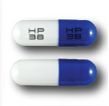Paromomycin Dosage
Medically reviewed by Drugs.com. Last updated on Mar 25, 2025.
Applies to the following strengths: 250 mg
Usual Adult Dose for:
Usual Pediatric Dose for:
Additional dosage information:
Usual Adult Dose for Amebiasis
25 to 35 mg/kg/day orally in 3 divided doses with meals for 5 to 10 days
Comments:
- This drug is not effective in extraintestinal amebiasis.
Use: For intestinal amebiasis (acute and chronic)
Usual Adult Dose for Hepatic Coma
4 g/day orally in divided doses (at regular intervals) for 5 to 6 days
Use: As adjunctive therapy, for management of hepatic coma
Usual Adult Dose for Dientamoeba fragilis
US CDC Recommendations: 25 to 35 mg/kg/day orally in 3 divided doses for 7 days
Comments:
- Recommended as a regimen to treat infection due to Dientamoeba fragilis
- Current guidelines should be consulted for additional information.
Usual Pediatric Dose for Amebiasis
25 to 35 mg/kg/day orally in 3 divided doses with meals for 5 to 10 days
Comments:
- This drug is not effective in extraintestinal amebiasis.
Use: For intestinal amebiasis (acute and chronic)
Usual Pediatric Dose for Dientamoeba fragilis
American Academy of Pediatrics Recommendations: 25 to 35 mg/kg/day orally in 3 divided doses for 7 days
Comments:
- Recommended as a regimen to treat infection due to D fragilis
- Current guidelines should be consulted for additional information.
Renal Dose Adjustments
Data not available
Liver Dose Adjustments
Data not available
Precautions
CONTRAINDICATIONS:
History of hypersensitivity reactions to the active component or any of the ingredients; intestinal obstruction
Consult WARNINGS section for additional precautions.
Dialysis
Data not available
Other Comments
Storage requirements:
- Store at 20C to 25C (68F to 77F) in tight container.
- Protect from moisture.
General:
- To reduce the development of drug-resistant organisms and maintain effective therapy, this drug should be used only to treat or prevent infections proven or strongly suspected to be caused by susceptible bacteria.
- Culture and susceptibility information should be considered when selecting/modifying antibacterial therapy or, if no data are available, local epidemiology and susceptibility patterns may be considered when selecting empiric therapy.
Patient advice:
- Avoid missing doses and complete the entire course of therapy.
- Consult physician for medical advice about side effects.
More about paromomycin
- Check interactions
- Compare alternatives
- Reviews (7)
- Drug images
- Side effects
- During pregnancy
- Drug class: amebicides
- Breastfeeding
- En español
Patient resources
Other brands
Professional resources
Other brands
Related treatment guides
See also:
Further information
Always consult your healthcare provider to ensure the information displayed on this page applies to your personal circumstances.


